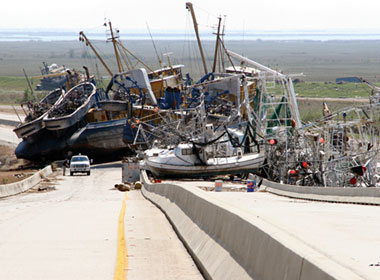
MARCH 2006

|
NATURAL DISASTERS
Warning: Disasters Ahead
ecent catastrophic events provide striking proof that we live on a planet where deadly disasters can strike with little or no warning. In the span of just a few months during 2004 and 2005 the world suffered three historic disasters: First, there was the tsunami in the Indian. Triggered by an earthquake off the coast of Sumatra, giant waves struck coastal areas, killing some 200,000 local citizens and tourists. Next there was a shattering earthquake that struck an area in Pakistan, Kashmir, India, and Afghanistan. About 70,000 died in the rubble of collapsed buildings. Then Hurricane Katrina hit the Gulf Coast and flooded New Orleans. A great city was mortally wounded. The lesson that we must learn is that such things have happened throughout the history of mankind. We’re surrounded by natural risks ranging from a world-destroying asteroid collision through a gamut of earthquakes, tsunamis, hurricanes, floods, tornadoes, blizzards, heat waves and volcanic eruptions. Mankind has made little progress in preventing these natural events. It is certain that they will happen again. Man-made disaster risks in our future include terrorism, nuclear accidents, epidemics, fires, explosions, aircraft accidents, explosions, ship sinkings, rail accidents, oil spills, structural failures, food poisoning, water pollution, toxic materials and just plain hysteria. Mankind has made some progress in reducing some of these threats, but most such events also will continue to happen. Among all of these risks, which ones pose the greatest threats? We believe the best answer is to examine the record. Thus we have compiled a database of more than 1,000 disasters that have occurred in our lifetime. (See “Conway Natural Disaster File” at www.sitenet.com). That was the first step. Next, we saw the need for a system for determining which disasters have the greatest impact. We were familiar with the well-known Richter scale for earthquakes and the Saffir-Simpson scale for hurricanes. These scales are very useful for measuring the strength of disaster events but they do not measure the extent of deaths and damage they cause. To meet this need, we have developed the new scale explained in the accompanying sidebar. Conclusions
The new rating system provides a significantly better picture of disaster risks worldwide. First, it confirms that we have witnessed some of the worst disasters of the past century in the space of a few months. It also makes it clear that disaster deaths are greatest in less developed nations where there are dense populations living in flimsy structures. The greatest property losses are in the developed nations where disasters destroy more expensive homes, businesses, and infrastructure. Comparing risks, a major asteroid collision is very unlikely. However, a big earthquake disaster in California seems almost certain. Perhaps the surest conclusion is that facility planners face an awesome challenge. McKinley Conway is author of the pioneering book Disaster Survival (291pp., maps, illus., ISBN 0-910436-17-7). Published in 1981, it is available via amazon.com. For more about the author, do a Google search for “McKinley Conway.”
|
©2006 Conway Data, Inc. All rights reserved. SiteNet data is from many sources and not warranted to be accurate or current.
|
